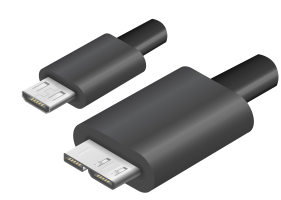
With USB cables it is possible to connect all kinds of devices to the computer. They are also used to charge smartphones, tablets and e-readers, among other things. They come in different variants.
Shape of the plugs
There is a plug at each end of a USB cable. The plug on the computer side always looks the same. For the device side, there are different variants: usb-b, usb-c, micro-usb, mini-usb and lightning.
USB plug: computer side
The plug that goes into the computer or laptop always has the same shape and looks just like a USB stick. After all, it also goes into the computer. And anyone who still uses a wired keyboard will certainly recognize the connection. An annoyance that everyone knows: this plug only fits one way. This is difficult to see when plugging into the computer. Often it is a matter of trying it out.
The plug on the computer side is called usb-a and looks like this:
.png)
USB plug: charging adapter
Most phones and tablets have an adapter with a plug that goes into the wall socket. The device to be charged is connected via a USB cable. The plug on the adapter side is always the same, just like with the computer: a USB-A.
USB plug: device side
On the other side of a USB cable is a plug that must be plugged into a device. Such as a printer, scanner, external hard drive, digital camera, tablet or smartphone. Here are some variations:
.png)
- usb-b
This is a square plug. Mainly used for printers.
- mini usb
Flat plug with a thick head. Mainly used with older devices.
- micro usb
The smallest and flattest plug. Recognizable to most people as the charging plug that goes into an Android phone. A new variant of micro-usb has a different shape. It is mainly used with external hard drives..png)
- usb-c
Plug with elliptical outlet. Made in such a way that it always fits.
- lightning
Plug used only by Apple. Including the iPad and iPhone.
Speed
USB cables have a so-called throughput rate, which indicates how quickly data is exchanged. That is only important when transferring data. For example, when you copy files from the computer to an external hard drive. The following versions exist: 1.0, 1.1, 2.0, 3.0 and 3.1. Newer versions have a higher throughput. The fastest USB cables have a blue interior.